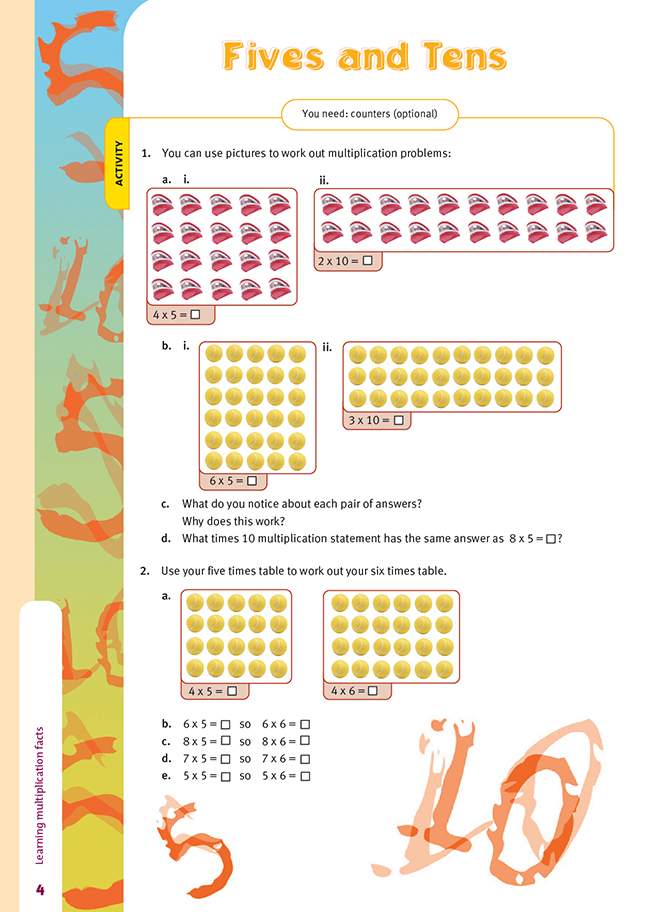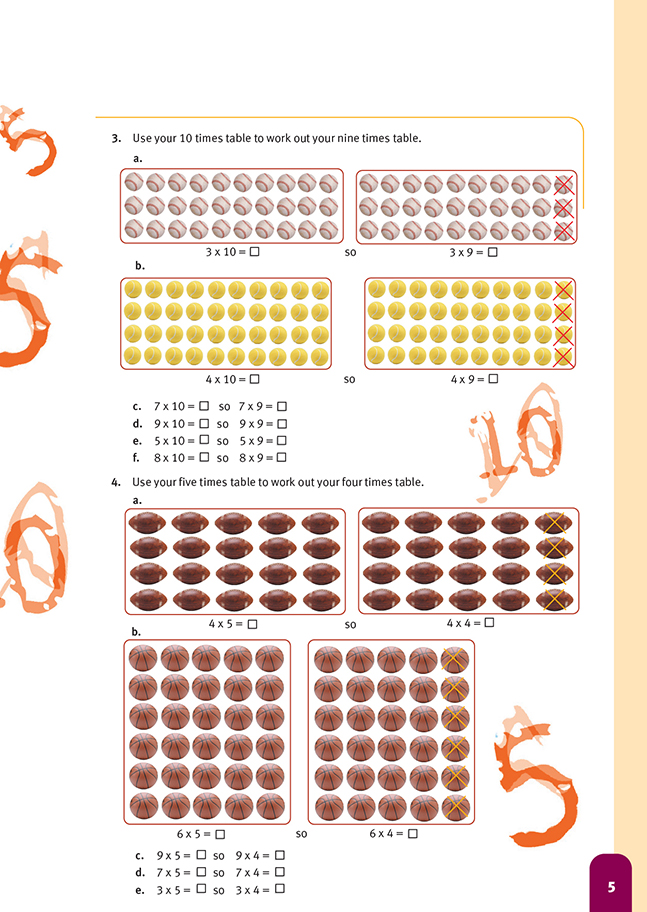This is a level 3 number link activity from the Figure It Out series. It relates to Stage 6 of the Number Framework.
A PDF of the student activity is included.
Click on the image to enlarge it. Click again to close. Download PDF (489 KB)
use arrays to solve multiplication facts
FIO, Link, Number, Book One, Fives and Tens, pages 4-5
Counters (optional)
The array pattern used here to model multiplication is an important pattern for students. It illustrates the “sets of” scenarios in which students should use multiplication to find the total. It’s an effective way of showing the relationships between the factors and the products (the family of facts).
The array pattern above shows a 4 by 3 arrangement that can also be described as a 3 by 4 arrangement. If we look at the rows, we can see how many fours there are in 12, while the columns show how many threes there are in 12. Encourage your students to see that a 4 by 3 view and a 3 by 4 view are different ways of looking at the same product of 12. This demonstrates a deeper understanding than simply saying that 3 x 4 is the same as 4 x 3.
When two factors are combined, as in the array above, the shape of the arrangement is often a rectangle. Conversely, all rectangles can be described by two factors, which represent the lengths of the sides. The product will be the area of the rectangle.
Prime factors are very useful in exploring array patterns. You may need to show the students how to turn the array factors into prime factors. For example, in question 1, 4 x 5 will be 2 x 2 x 5. By recombining these factors in different ways, the students will see all the possible arrays that they can make. In this case, (2 x 2) x 5 = 4 x 5, whereas 2 x (2 x 5) = 2 x 10. This would be useful in question 1d, where 8 x 5 expressed as prime factors is (2 x 2 x 2) x 5, which can be regrouped as (2 x 2) x (2 x 5) to become 4 x 10. This work will give the students a powerful appreciation of the associative property for multiplication.
Another useful strategy is to use doubling and halving. For example, in 8 x 5 = 40, you can halve the 8 and double the 5 to get 4 x 10 = 40.
In questions 2 and 3, the students derive unknown facts from known ones. After they see the connections modelled here, the students should see that this deriving strategy can be used for any multiplication situation. For example, 4 x 19 can be derived from 4 x 20 by subtracting a 4.
Students who have only a “sets of ” interpretation for multiplication equations may have difficulty understanding this strategy.
Ensure that your students understand how to change their view of the first equation to match up to the second equation. For example, to use 6 x 5 = to work out 6 x 6 = , they may have to change their interpretation of 6 x 5 as six lots of 5 to the equivalent form of 5 x 6 as five lots of 6 to enable them to see the connection with 6 x 6 as six lots of 6.
Answers to Activity
1. a. i. 20
ii. 20
b. i. 30
ii. 30
c. Each pair has the same answer. It works because there is the same number of shapes in each array, but they are arranged differently.
d. 4 x 10
2. a. 4 x 5 = 20, 4 x 6 = 24
b. 6 x 5 = 30, 6 x 6 = 36
c. 8 x 5 = 40, 8 x 6 = 48
d. 7 x 5 = 35, 7 x 6 = 42
e. 5 x 5 = 25, 5 x 6 = 30
3. a. 3 x 10 = 30, 3 x 9 = 27
b. 4 x 10 = 40, 4 x 9 = 36
c. 7 x 10 = 70, 7 x 9 = 63
d. 9 x 10 = 90, 9 x 9 = 81
e. 5 x 10 = 50, 5 x 9 = 45
f. 8 x 10 = 80, 8 x 9 = 72
4. a. 4 x 5 = 20, 4 x 4 = 16
b. 6 x 5 = 30, 6 x 4 = 24
c. 9 x 5 = 45, 9 x 4 = 36
d. 7 x 5 = 35, 7 x 4 = 28
e. 3 x 5 = 15, 3 x 4 = 12


